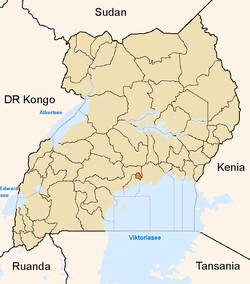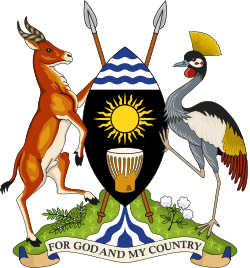Bank of Uganda
| Headquarters | Kampala, Uganda |
|---|---|
| Governor | Emmanuel Tumusiime Mutebile |
| Central bank of | Uganda |
| Currency |
Uganda Shilling UGX (ISO 4217) |
| Reserves | US$3.276 billion[1] |
| Website | Official site |
| Assets = US$8.2 billion (2013) | |
The Bank of Uganda (BOU) is the Central Bank of the Republic of Uganda. Established in 1966, by Act of Parliament, BOU is 100% owned by the Government of Uganda, but is not a government department.
Organization and Governance
The Board of Directors of the Bank of Uganda is the supreme policy making body of the Bank. It is chaired by the Governor and in his/her absence by the Deputy Governor. The duties and powers of the Board are provided for under the Bank of Uganda Act. This Act bestows upon the Board the responsibility for the general management of the affairs of the Bank. The Board formulates Bank policies and ensures that anything required to be done by the Bank under the statute as well as anything else that is within or incidental to the functioning of the Bank is carried out.
The President of Uganda appoints both the Governor of the Bank and the Deputy Governor, on the advice of the Cabinet for five-year renewable terms. Other members of the Board (not less than four, and not more than six, are appointed by the Minister of Finance for three-year renewable terms. The Secretary to the Treasury is an ex-officio member of the Board. The current Governor is Professor Emmanuel Tumusiime-Mutebile and the Deputy Governor is Dr. Louis Kasekende.[2]
Duties
In the process of fulfilling the Bank's mission, the Bank carries out the following functions:
- Issue Uganda's national currency/legal tender, the Uganda Shilling (UGX)
- Regulate money supply using monetary policy
- Act as Banker to the Government of Uganda
- Act as Banker to Commercial Banks
- Supervise and regulate Financial Institutions in Uganda
- Manage the country's external/foreign reserves
- Manage Uganda's external debt
- Advise the Government of Uganda on financial and economic issues
Currency centers
The central bank maintains currency centers in various locations around the country, whose purpose is to store, process and monitor the supply of currency to the government and private financial institutions in the surrounding cities, towns and villages. There are a total of nine currency centers in the following cities and towns:
- Arua Currency Center - Arua
- Fort Portal Currency Center - Fort Portal
- Gulu Currency Center - Gulu
- Jinja Currency Center - Jinja
- Kabale Currency Center - Kabale[3]
- Kampala Currency Center - Kampala
- Masaka Currency Center - Masaka
- Mbale Currency Center - Mbale
- Mbarara Currency Center - Mbarara
Financial Inclusion
Bank of Uganda is active in promoting the policy of financial inclusion, and is a leading member of the Alliance for Financial Inclusion. BOU is also one of the original 17 regulatory institutions to make specific national commitments to financial inclusion under the Maya Declaration, during the Global Policy Forum held in Riviera Maya, Mexico in 2011.[4]
See also
- Uganda Shilling
- List of banks in Uganda
- Banking in Uganda
References
- ↑ Oketch, Martin Luther (10 April 2014). "Forex Reserves Increase by Shs584 Billion". Daily Monitor. Retrieved 20 April 2014.
- ↑ "Governance and Organisation of the Bank". Bank of Uganda. Retrieved 20 April 2014.
- ↑ Uwera, Runyambo (12 April 2010). "Central Bank Launches Currency Centre". Daily Monitor. Retrieved 20 April 2014.
- ↑ Alliance, for Financial Inclusion (30 September 2011). "Maya Declaration Urges Financial Inclusion for World's Unbanked Populations". PR Newswire. Retrieved 20 April 2014.
External links
- Bank of Uganda Website
- Uganda Ministry of Finance
- Bank of Uganda Annual Financial Stability Reports
- Mixed Bag of Banking Stars
| |||||||||||||||||||||||||||||||||||||||||

